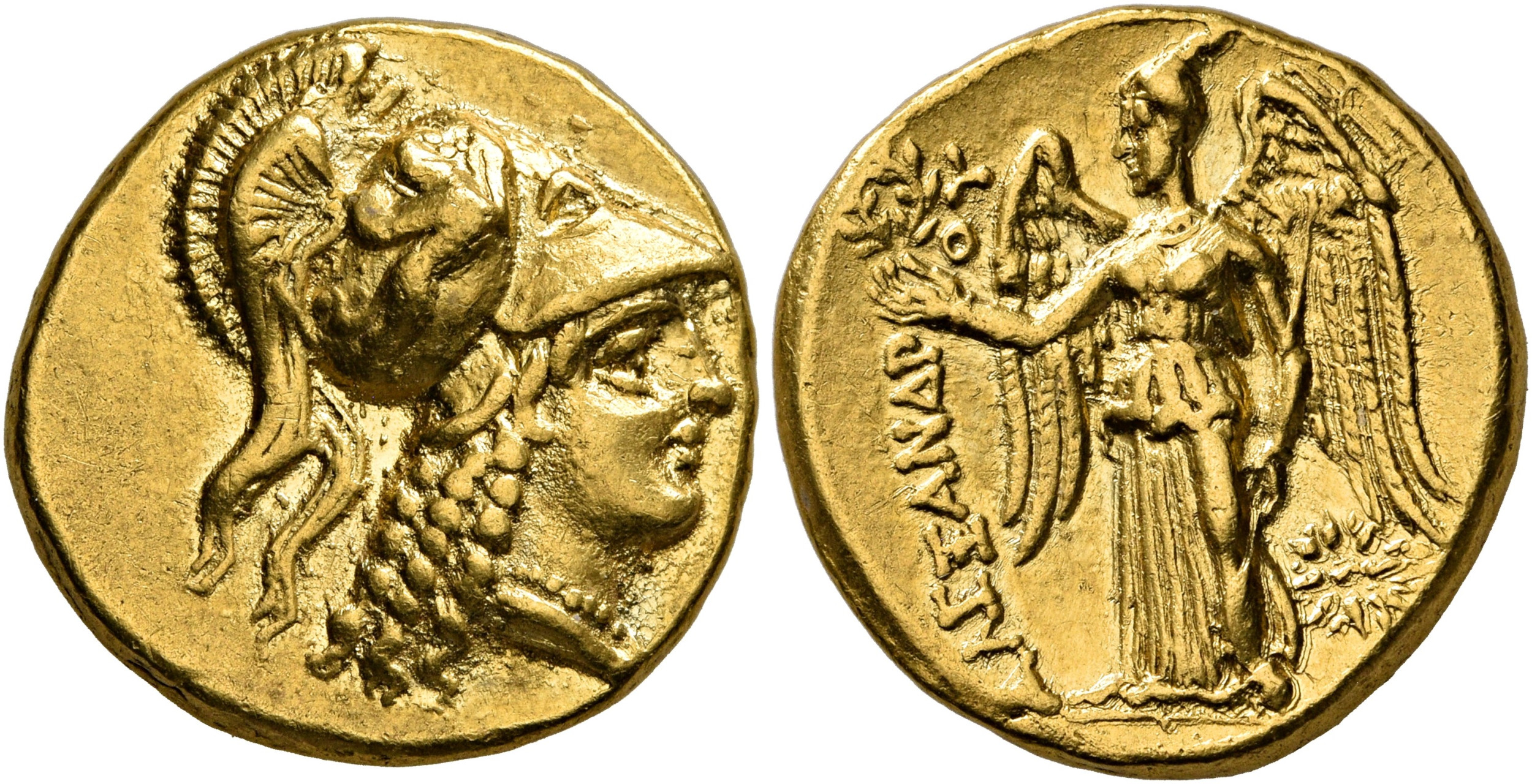Tarsus (Alexander the Great), gold, staters (333-319 BCE)
From SILVER
333 BCE - 319 BCE Gold 41,727 kg
Description
| ObverseInscription or printing placed on the obverse.: | Head of Athena to right, wearing crested Corinthian helmet decorated with a griffin springing right. |
| ReverseInscription or printing placed on the reverse.: | AΛΕΞΑΝΔΡΟΥ (Greek).AΛEΞANΔΡOΥ Nike standing front, head to left, with her wings spread, holding laurel wreath in her right hand and stylis in her left, below right wing, star. |
Mint and issuing power
| MintIdentifies the place of manufacture or issue of a numismatic object.: | Tarsus | Ancient regionAncient region.: | Cilicia | Modern countryModern country: Turkey | AuthorityIdentifies the issuing power. The authority can be "pretended" when the name or the portrait of X is on the coin but he/she was not the issuing power. It can also be "uncertain" when there is no mention of X on the coin but he/she was the issuing power according to the historical sources: | Alexander III the Great (Argead king, 336-323 BC) |
Chronology
| FromIdentifies the initial date in a range assigned in a numismatic context. | 333 BCE | toIdentifies the final date in a range assigned in a numismatic context.. | 319 BCE | PeriodTime period of the numismatic object.: Classical and Hellenistic |
Physical description
| MetalThe physical material (usually metal) from which an object is made.: | Gold |
Median weightMedian of the weights of numismatic objects (in grams). in grams | 8.60 | DenominationTerm indicating the value of a numismatic object. Examples: tetradrachm, chalkous, denarius.: | stater |
StandardStandard.: | Attic |
Image

H268 Tarsos.jpeg [1]
References
| Die study referencePublication of the study: | Newell 19181Newell 1918, p. 69-115, pl. 1-8. | ||
| Coin series referenceReference to coin series study: | Price 19912Price 1991, n° 3004-3010, RQEMH3RQEMH, n° 268 | ||
| Coin series web referenceCoin series web references: | |||
Obverse dies distribution
| FrequencyFrequency of specimen in distribution. ᵖ | Number of obversesNumber of obverse dies. ᵖ (o) | % (o) | Number of coinsNumber of coins. (n) | % (n) | Die nameName(s) of the die(s). |
| 1 | 8 | 50 | 8 | 22.86 | A, B, D, E, F, G, L, P |
| 2 | 3 | 18.75 | 6 | 17.14 | C, N, Q |
| 3 | 1 | 6.25 | 3 | 8.57 | M |
| 4 | 2 | 12.5 | 8 | 22.86 | H, K |
| 5 | 2 | 12.5 | 10 | 28.57 | J, O |
| Total | 16 of 16 | 100 | 35 of 35 | 100 |
Reverse dies distribution
no distribution is available
Quantification
| Number of obversesNumber of obverse dies. ᵖ (o) | 16 | Number of singletons (o1)The number of singleton coins. ᵖ | 8 |
| Number of reverse diesNumber of reverse dies. (r) | 19 | Number of coinsNumber of coins. (n) | 35 |
| Coins per obverse dieNumber of coins per obverse die. (n/o) | 2.19 | Coins per reverse dieNumber of coins per reverse die. (n/r) | 1.84 |
| Reverse per obverse ratioRatio of obverse dies divided by reverse dies. (r/o) | 1.19 | Percentage of singletons (o1)number of coins (n) divided by the number of singletons (o1) ᵖ | 50 % |
| Original number of dies (O) (Carter 1983 formula)The estimation of the number of coins according to Carter 1983 ᵖ | 24.26 | Coins struck if 20,000 as average productivity per dieCoins made if the average productivity for obverses (according to Carter) is 20,000. ᵖ | 485,200 |
| Original number of dies (O) (Esty 2011 formula)The estimation of the number of coins according to the singleton formula in Esty 2011 ᵖ (O) | 29.47 | Survival rate if 20,000 as average productivity per dieSurvival rate if average productivity is 20,000. ᵖ | 0.00007 |
| Coverage (o = % of O) (Esty 1984 formula)Esty 1984 - coverage (% of O) ᵖ (o = % of O) | 77.14% | Die productivity if survival rate 1/2,000Average productivity if survival rate is 1/2,000. ᵖ | 2,885.41 |
| Weight of silver (in kg) if 20,000 coins per die (O = Carter formula)Carter 1983 * Median weight * 20000 (*10 if gold or electrum) ᵖ | 41,727 kg <br /> 41,727 kg | Die productivity if survival rate 1/5,000Average productivity if survival rate is 1/5,000. ᵖ | 7,213.52 |
Remarks